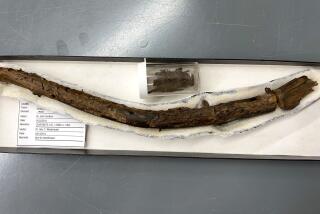Resuscitating Nature: Rare Plants Revived
ATLANTA — Scientists hacked their way through the underbrush of north Georgia’s mountains in search of some of the country’s most endangered plants.
Having caught a few precious seeds, they carefully scraped off tiny bits of tissue, packed them in ice for the trip to their laboratory and then set about cloning them.
From those fragile bits came hundreds of seedlings that are being replanted in the wild and in back yards alike as part of an aggressive program to revitalize endangered species.
“We’re not only rescuing these plants,” said Ron Determann of the Atlanta Botanical Garden. “We’re expanding the gene pools so the plants are more diverse and can adapt and survive in the changing environment.”
Conservationists estimate 800 of the nation’s native species could be extinct within a decade, but until recently they merely tried to protect surviving clumps.
Now horticulturists around the country are racing to sow seeds, root cuttings and clone leaves to propagate disappearing plants and encourage the genetic diversity they need to survive.
“Using horticulture as a tool for conservation has made us readjust our thinking pretty dramatically,” said Don Falk, executive director of the Center for Plant Conservation at the Missouri Botanical Garden.
But it’s catching on:
* Hawaii’s Lyon Arboretum is collecting tissue samples of 60 plant species in danger of immediate extinction so it can clone and save them.
* A nursery in Billings, Mont., clones rare plants for nurseries, the largest such commercial operation.
* The Atlanta Botanical Garden has reproduced 2,000 pitcher plants, which are insect-eating tube-shaped plants that have almost completely disappeared from their native mountain bogs in the Southeast. It’s also rooting cuttings of the world’s last 150 stinking cedar trees, a member of the yew family. Yews provide the cancer drug taxol, but nobody knows if the stinking cedar has medicinal benefits because none of the remaining trees are fully grown.
* The University of Georgia cloned hundreds of fringed campion, a lacy pink flower, and other disappearing Southeast plants.
The offspring of endangered plants are being replanted on public land and even in back-yard gardens.
“A lot of gardeners want these plants,” said Rick Berry, whose nursery in Lexington, Ga., sold out of the fringed campion clones. “They want something special, and they like the idea of perpetuating an endangered species.”
Many conservationists are leery of putting endangered plants in just anyone’s hands. They fear that a plant introduced to the wrong environment could take over, like the fast-growing imported kudzu vine has in some parts of the South.
But “if you can educate gardeners about each plant and where it needs to grow, they could be very effective in helping repopulate endangered species,” said Mildred Pannell, a horticulturist at the Atlanta Botanical Garden.
More to Read
Sign up for Essential California
The most important California stories and recommendations in your inbox every morning.
You may occasionally receive promotional content from the Los Angeles Times.










